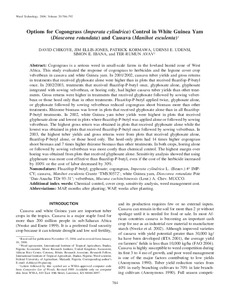| dc.contributor.author | Chikoye, D. |
| dc.contributor.author | Ellis-Jones, J. |
| dc.contributor.author | Kormawa, P. |
| dc.contributor.author | Udensi, U. |
| dc.contributor.author | Ibana, S. |
| dc.contributor.author | Avav, T. |
| dc.date.accessioned | 2019-12-04T11:18:36Z |
| dc.date.available | 2019-12-04T11:18:36Z |
| dc.date.issued | 2006 |
| dc.identifier.citation | Chikoye, D., Ellis-Jones, J., Kormawa, P., Udensi, U., Ibana, S. & Avav, T. (2006). Options for cogongrass (Imperata cylindrica) control in white Guinea yam (Dioscorea rotundata) and cassava (Manihot esculenta). Weed Technology, 20(3), 784-792. |
| dc.identifier.issn | 0890-037X |
| dc.identifier.uri | https://hdl.handle.net/20.500.12478/3264 |
| dc.description.abstract | Cogongrass is a serious weed in small-scale farms in the lowland humid zone of West Africa. This study evaluated the response of cogongrass to herbicides and the legume cover crop velvetbean in cassava and white Guinea yam. In 2001/2002, cassava tuber yields and gross returns in treatments that received glyphosate alone were higher than in plots that received fluazifop-P-butyl once. In 2002/2003, treatments that received fluazifop-P-butyl once, glyphosate alone, glyphosate integrated with sowing velvetbean, or hoeing only, had higher cassava tuber yields than other treatments. Gross returns were higher in treatments that received glyphosate followed by sowing velvetbean or those hoed only than in other treatments. Fluazifop-P-butyl applied twice, glyphosate alone, or glyphosate followed by sowing velvetbean reduced cogongrass shoot biomass more than other treatments. Rhizome biomass was lower in plots that received glyphosate alone than in all fluazifop-P-butyl treatments. In 2002, white Guinea yam tuber yields were highest in plots that received glyphosate alone and lowest in plots where fluazifop-P-butyl was applied alone or followed by sowing velvetbean. The highest gross return was obtained in plots that received glyphosate alone while the lowest was obtained in plots that received fluazifop-P-butyl once followed by sowing velvetbean. In 2003, the highest tuber yields and gross returns were from plots that received glyphosate alone, fluazifop-P-butyl alone, or those hoed only. The hoed-only plots had 14 times higher cogongrass shoot biomass and 7 times higher rhizome biomass than other treatments. In both crops, hoeing alone or followed by sowing velvetbean was more costly than chemical control. The highest margin over hoeing was obtained from plots that received glyphosate alone. Sensitivity analysis showed that using glyphosate was more cost effective than fluazifop-P-butyl, even if the cost of the herbicide increased by 100% or the cost of labor decreased by 30%. |
| dc.description.sponsorship | Department for International Development, United Kingdom |
| dc.language.iso | en |
| dc.subject | Chemical Control |
| dc.subject | Cover Crop |
| dc.subject | Sensitivity Analysis |
| dc.subject | Weed Management Cost |
| dc.title | Options for cogongrass ((Imperata cylindrica) control in white guinea yam (Dioscorea rotundata) and cassava (Manihot esculenta)1 |
| dc.type | Journal Article |
| dc.description.version | Peer Review |
| cg.contributor.affiliation | International Institute of Tropical Agriculture |
| cg.contributor.affiliation | Silsoe Research Institute |
| cg.contributor.affiliation | Africa Rice Center |
| cg.contributor.affiliation | Federal University of Agriculture, Nigeria |
| cg.coverage.region | Africa |
| cg.coverage.region | West Africa |
| cg.coverage.country | Nigeria |
| cg.isijournal | ISI Journal |
| cg.authorship.types | CGIAR and developing country institute |
| cg.iitasubject | Cassava |
| cg.iitasubject | Yam |
| cg.iitasubject | Plant Production |
| cg.iitasubject | Weeds |
| cg.iitasubject | Genetic Improvement |
| cg.accessibilitystatus | Limited Access |
| local.dspaceid | 94938 |
| cg.identifier.doi | http://dx.doi.org/10.1614/WT-04-310R2.1 |

